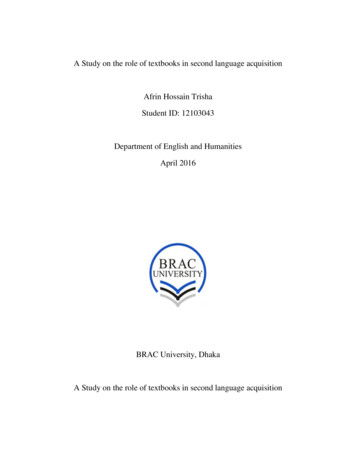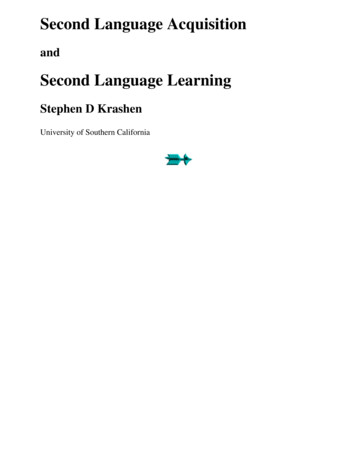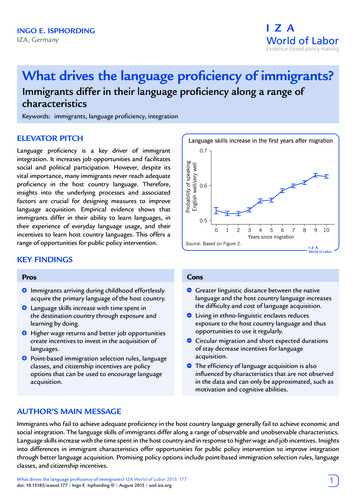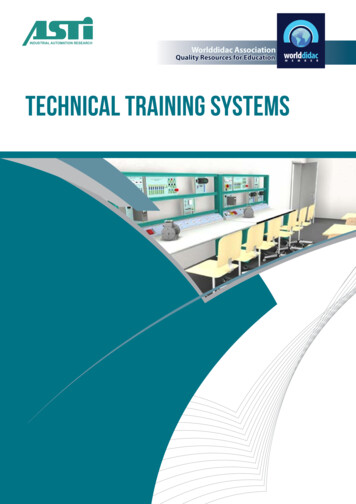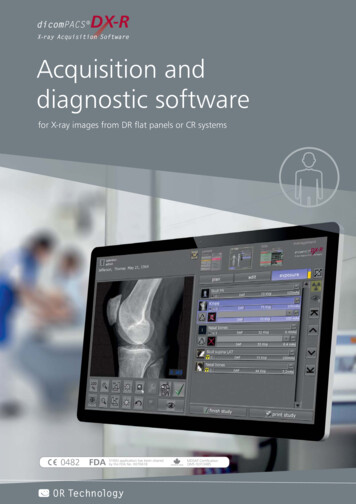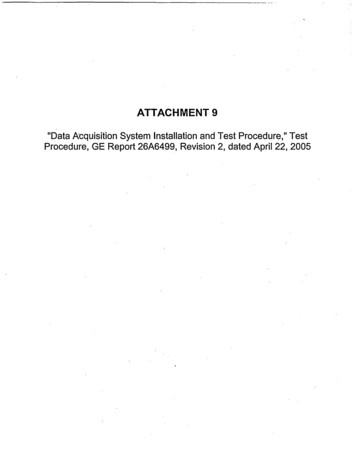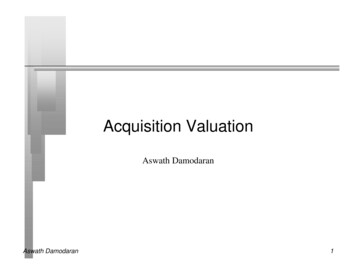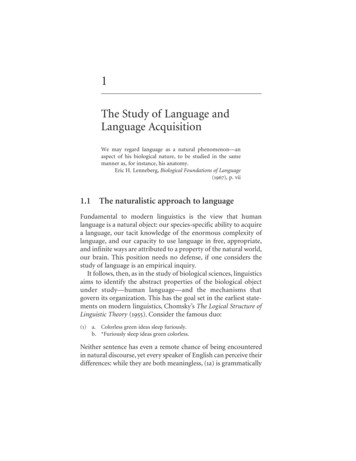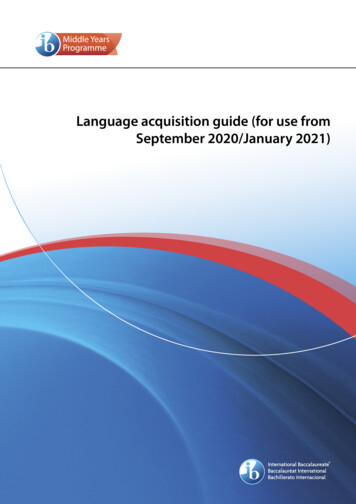
Transcription
Language acquisition guide (for use fromSeptember 2020/January 2021)
Language acquisition guide (for use fromSeptember 2020/January 2021)
Middle Years ProgrammeLanguage acquisition guidePublished February 2020Published on behalf of the International Baccalaureate Organization, a not-for-profiteducational foundation of 15 Route des Morillons, 1218 Le Grand-Saconnex, Geneva,Switzerland by theInternational Baccalaureate Organization (UK) LtdPeterson House, Malthouse Avenue, Cardiff GateCardiff, Wales CF23 8GLUnited KingdomWebsite: ibo.org International Baccalaureate Organization 2020The International Baccalaureate Organization (known as the IB) offers four high-qualityand challenging educational programmes for a worldwide community of schools, aimingto create a better, more peaceful world. This publication is one of a range of materialsproduced to support these programmes.The IB may use a variety of sources in its work and checks information to verify accuracyand authenticity, particularly when using community-based knowledge sources such asWikipedia. The IB respects the principles of intellectual property and makes strenuousefforts to identify and obtain permission before publication from rights holders of allcopyright material used. The IB is grateful for permissions received for material usedin this publication and will be pleased to correct any errors or omissions at the earliestopportunity.All rights reserved. No part of this publication may be reproduced, stored in a retrievalsystem, or transmitted, in any form or by any means, without the IB’s prior writtenpermission, or as expressly permitted by the Rules for use of IB Intellectual Property.IB merchandise and publications can b e purchase d through the IB Store(email: sales@ ibo. org). Any commercial use of IB publications (whether fee-covered orcommercial) by third parties acting in the IB’s ecosystem without a formal relationshipwith the IB (including but not limited to tutoring organizations, professional developmentproviders, educational publishers and operators of curriculum mapping or teacherresource digital platforms etc) is prohibited and requires a subsequent written licensefrom the IB. License requests should be sent to copyright@ibo.org. More information canbe obtained on the IB public website.International Baccalaureate, Baccalauréat International, Bachillerato Internacionaland IB logos are registered trademarks of the International Baccalaureate Organization.
IB mission statementThe International Baccalaureate aims to develop inquiring, knowledgeable and caring young people whohelp to create a better and more peaceful world through intercultural understanding and respect.To this end the organization works with schools, governments and international organizations to developchallenging programmes of international education and rigorous assessment.These programmes encourage students across the world to become active, compassionate and lifelonglearners who understand that other people, with their differences, can also be right.
IBEHL E ARNERTIB learner profileprofile IB learnerarner profile IB leile IB learner profIB learner profileer profile IB learnPROFILEIB learner profileThe aim of all IB programmes is to develop internationally minded people who, recognizing their commonhumanity and shared guardianship of the planet, help to create a better and more peaceful world.As IB learners we strive to be:We nurture our curiosity, developing skills for inquiry andresearch. We know how to learn independently and with others.We learn with enthusiasm and sustain our love of learningthroughout life.We critically appreciate our own cultures and personal histories,as well as the values and traditions of others. We seek and evaluatea range of points of view, and we are willing to grow from theexperience.We develop and use conceptual understanding, exploringknowledge across a range of disciplines. We engage with issuesand ideas that have local and global significance.We show empathy, compassion and respect. We have acommitment to service, and we act to make a positive differencein the lives of others and in the world around us.We use critical and creative thinking skills to analyse and takeresponsible action on complex problems. We exercise initiative inmaking reasoned, ethical decisions.We approach uncertainty with forethought and determination;we work independently and cooperatively to explore new ideasand innovative strategies. We are resourceful and resilient in theface of challenges and change.We express ourselves confidently and creatively in more than onelanguage and in many ways. We collaborate effectively, listeningcarefully to the perspectives of other individuals and groups.We act with integrity and honesty, with a strong sense offairness and justice, and with respect for the dignity and rightsof people everywhere. We take responsibility for our actionsand their consequences.We understand the importance of balancing different aspects ofour lives—intellectual, physical, and emotional—to achievewell-being for ourselves and others. We recognize our interdependence with other people and with the world in which we live.We thoughtfully consider the world and our own ideas and experience. We work to understand our strengths and weaknesses inorder to support our learning and personal development.The IB learner profile represents 10 attributes valued by IB World Schools. We believe these attributes, and otherslike them, can help individuals and groups become responsible members of local, national and global communities. International Baccalaureate Organization 2017International Baccalaureate Baccalauréat International Bachillerato Internacional
ContentsIntroduction1Purpose of this guide1Language acquisition in the MYP2MYP programme model2Nature of language acquisition4Language acquisition across the IB continuum5Aims7Objectives8Teaching and learning with multimodal texts12Planning a progression of learning14Interdisciplinary learning17MYP projects18Written and taught curriculum19Requirements19Planning the language acquisition curriculum21Teaching and learning through inquiry26Subject-specific guidance32Assessed curriculum36Alignment of objectives and criteria36Assessment criteria overview37Language acquisition assessment criteria38MYP eAssessment50Appendices64Related concepts in language acquisition64Language acquisition glossary66MYP command terms for language acquisition73Bibliography74Language acquisition guide (for use from September 2020/January 2021)
IntroductionPurpose of this guideThis guide is for use from September 2020 or January 2021 depending on the start of the school yearThis document provides the framework for teaching and learning in language acquisition in the MiddleYears Programme (MYP) and must be read and used in conjunction with the document MYP: From principlesinto practice, which includes:i.general information about the programmeii.the MYP unit planner, with guidance for developing the curriculum that is relevant for all subjectgroupsiii.detailed information about approaches to learningiv.advice that supports access and inclusion (including accommodations for students with learningsupport requirements)v.a statement on academic honesty.In MYP publications, requirements appear in a text box like this one.Additional resourcesTeacher support material (TSM) is available in the programme resource centre (resources.ibo.org). The TSMfor language acquisition contains support for developing the written, taught and assessed curriculum. Itprovides examples of good practice, including subject-group overviews, assessment tasks andmarkschemes, as well as student work with teacher comments.An optional process of externally-moderated assessment can lead to IB MYP course results for languageacquisition, which is explained in the eAssessment section of this guide, and these results can contribute tothe awarding of an IB MYP certificate. More information is available in the annual publication Middle YearsProgramme Assessment procedures.A range of publications that support the MYP are available at the IB store at store.ibo.org.AcknowledgmentsThe IB gratefully acknowledges the generous contributions of IB World Schools and a global community ofeducators who collaborate in the development of the Middle Years Programme.Language acquisition guide (for use from September 2020/January 2021)1
Language acquisition in the MYPMYP programme modelFigure 1Middle Years Programme modelThe MYP is designed for students aged 11 to 16. It provides a framework of learning that encouragesstudents to become creative, critical and reflective thinkers. The MYP emphasizes intellectual challenge,encouraging students to make connections between their studies in traditional subjects and the real world.It fosters the development of skills for communication, intercultural understanding and global engagement—essential qualities for young people who are becoming global leaders.The MYP is flexible enough to accommodate the demands of most national or local curriculums. It buildsupon the knowledge, skills and attitudes developed in the IB Primary Years Programme (PYP) and preparesstudents to meet the academic challenges of the IB Diploma Programme (DP) and the IB Career-relatedProgramme (CP).The MYP: holistically addresses students’ intellectual, social, emotional and physical well-being provides students with opportunities to develop the knowledge, attitudes and skills they need inorder to manage complexity and take responsible action for the future ensures breadth and depth of understanding through study in eight subject groups2Language acquisition guide (for use from September 2020/January 2021)
MYP programme model requires the study of at least two languages to support students in understanding their own culturesand those of others empowers students to participate in service with the community helps to prepare students for further education, the workplace and a lifetime of learning.Language acquisition guide (for use from September 2020/January 2021)3
Language acquisition in the MYPNature of language acquisitionLearning to speak another’s language means taking one’s place in the human community. Itmeans reaching out to others across cultural and linguistic boundaries. Language is far more thana system to be explained. It is our most important link to the world around us. Language is culturein motion. It is people interacting with people.Savignon (1983)The ability to communicate in a variety of modes in more than one language is essential to the concept ofan international education that promotes multilingualism and intercultural understanding, both of whichare central to the IB’s mission.All IB programmes require the students to study, or study in, more than one language becausewe believe that communicating in more than one language provides excellent opportunities todevelop intercultural understanding and respect.What is an IB education? (2013, updated 2017)The study of additional languages in the MYP provides students with the opportunity to develop insightsinto the features, processes and craft of language and the concept of culture, and to realize that there arediverse ways of living, behaving and viewing the world.The acquisition of the language of a community and the possibilities to reflect upon and explore culturalperspectives of our own and other communities: are valued as central to developing critical thinking, and are considered essential for the cultivation ofintercultural awareness and the development of internationally-minded and responsible members oflocal, national and global communities are integral to exploring and sustaining personal development and cultural identity, and provide anintellectual framework to support conceptual development greatly contribute to the holistic development of students and to the strengthening of lifelonglearning skills equip students with the necessary multiliteracy skills and attitudes, enabling them to communicatesuccessfully in various global contexts and build intercultural understanding.To assist in achieving these broader goals, this guide provides both teachers and students with clear aimsand objectives for MYP language acquisition, as well as details of internal assessment requirements.4Language acquisition guide (for use from September 2020/January 2021)
Language acquisition in the MYPLanguage acquisition across the IB continuumThe IB continuum of international education provides a progression of learning for students aged 3 to 19.MYP language acquisition builds on experiences in language learning that students have gained duringtheir primary years. In IB World Schools offering the PYP, all students have the opportunity to learn morethan one language from at least the age of seven. In the MYP, students learn a minimum of two languagesand are encouraged to learn more. Knowledge, conceptual understanding and skills will have beendeveloped in the PYP through transdisciplinary units of inquiry or independent language inquiry. The sixskill areas in PYP language—listening, speaking, reading, writing, viewing and presenting—are furtherdeveloped through the MYP years. Students wishing to continue on to the DP or CP will be grounded in atleast one additional language, and will have developed an inquiring, reflective approach to languagelearning.The DP offers a comprehensive range of language courses in two groups. Studies in language and literature (group 1) Language acquisition (group 2)DP students may study one course in the subject group studies in language and literature (group 1) and one course inlanguage acquisition (group 2).or two courses in the subject group studies in language and literature (group 1).The courses in the MYP language acquisition subject group and the DP language acquisition subject groupshare some common aims, namely to: encourage students to gain competence in an additional language with the long-term goal ofmultilingualism enable students to develop lifelong learning skills encourage students to develop an awareness and understanding of the perspectives of people fromother cultures.Language acquisition in the MYP aims to develop a respect for, and understanding of, other languages andcultures, and is equally designed to equip the student with a skills base to facilitate further languagelearning.The MYP structures additional language learning in phases so that the complexity and range of languageprofiles that students bring to their MYP classroom is acknowledged and fostered. Students beginning theirMYP studies may have exited from any of the five phases of PYP language or may have no prior knowledgeor experience of the language to be studied in the MYP.The pathways to study language beyond MYP language acquisition are multiple. For example, phases 4, 5and 6 allow for a smooth transition from MYP language acquisition courses to DP language acquisitioncourses (group 2) and studies in language and literature courses (group 1). It is recommended that MYPlanguage acquisition courses are planned with consideration of the students’ possible pathways to the DP,CP or further study if they are not attending an IB continuum school.The MYP framework for the language acquisition subject group is designed to reflect the concepts andskills that make up the presumed knowledge for the DP language acquisition courses and CP languagedevelopment. MYP students continuing on to the DP will have developed not only an inquiring andreflective approach to language learning but also multiliteracy skills that they will be able to apply andextend in their DP language courses.Language acquisition guide (for use from September 2020/January 2021)5
Language acquisition across the IB continuumIn all four IB programmes, language learning is recognized as a developmental process in which studentshave opportunities to build on prior knowledge and skills in order to help them progress to the next phaseof language development.The knowledge, skills and attitudes that students develop in language acquisition courses provide ameaningful foundation for these further studies and the world of work in global economies andinternational business.For a comprehensive outline of the continuum of language and learning within the four IB programmes, aswell as a common pedagogy for language and learning, please see Language and learning in IB programmes.Table 1 shows possible IB continuum pathways from MYP through to DP or CP studies in language.Note: This is an indication only—it is up to schools to decide the minimum requirements for progressionfrom MYP to DP language acquisition courses and CP language development.Table 1Possible IB continuum pathwaysStart of MYP 1MYPSchools may offerEmergentintroductory MYPlanguageacquisition courses(languages carousel Capablecourses) andconsider thestudent’s previous Proficientlearning in thelanguage duringprimary schooleducation in orderto determineplacement.Refer to the writtenand taughtcurriculumrequirementssection in thisguide.DPCPPhase 1Ab initioPhase 2Ab initio (in rare cases)If the CP student istaking a DP languageacquisition course,refer to theplacementrecommendationsshown in the DPcolumn to the left.Language B SLPhase 3Language B SLPhase 4Language B SL/HLPhase 5Language B SL /HLLanguage A: literature SLLanguage A: language andliterature SLLiterature and performance SLPhase 6Language A: literature SL/HLLanguage A: language andliterature SL/HLIf the CP student isnot taking a DPlanguage acquisitioncourse, refer to theCP languagedevelopment guideforrecommendations.Literature and performance SLWhere possible, it is recommended that the student has at least one semester in MYP language andliterature before starting the DP courses listed in Table 1.MYP students in this language acquisition phase 6 could prepare and register for the IB MYP bilingualcertificate by taking two language and literature on-screen examinations.A student who achieves phase 6 early in the MYP (year 1–3) could progress to a language and literaturecourse in the same language in year 4 and 5. In this case, the students would be eligible for an IB MYPbilingual certificate by taking two on-screen examinations in language and literature.6Language acquisition guide (for use from September 2020/January 2021)
Language acquisition in the MYPAimsThe aims of all MYP subjects state what a teacher may expect to teach and what a student may expect toexperience and learn. These aims suggest how the student’s multi-literacy skills, conceptual and intercultural understandings may be developed through the learning experience.An overarching aim of teaching and learning languages is to enable the student to become a critical andcompetent communicator.The aims of the teaching and learning of MYP language acquisition are to: gain proficiency in an additional language while supporting maintenance of their mother tongue andcultural heritage develop a respect for, and understanding of, diverse linguistic and cultural heritages develop the student’s communication skills necessary for further language learning, and for study,work and leisure in a range of authentic contexts and for a variety of audiences and purposes enable the student to develop multiliteracy skills through the use of a range of learning tools, such asmultimedia, in the various modes of communication enable the student to develop an appreciation of a variety of literary and non-literary texts and todevelop critical and creative techniques for comprehension and construction of meaning enable the student to recognize and use language as a vehicle of thought, reflection, self-expressionand learning in other subjects, and as a tool for enhancing literacy enable the student to understand the nature of language and the process of language learning, whichcomprises the integration of linguistic, cultural and social components offer insight into the cultural characteristics of the communities where the language is spoken encourage an awareness and understanding of the perspectives of people from their own and othercultures, leading to involvement and action in their own and other communities foster curiosity, inquiry and a lifelong interest in, and enjoyment of, language learning.Language acquisition guide (for use from September 2020/January 2021)7
Language acquisition in the MYPObjectivesIn the context of the language acquisition subject-group framework, to be multiliterate is defined as beingable to understand and use print-based and digital spoken, written and visual text. Meaning in text isconstructed and presented in linguistic mode but also in visual, auditory, gestural and spatial mode (Evanset al. 2008a: 2). These various modes must all be understood in combination with each other and areincreasingly combined and integrated to construct meaning. The current generation of students arerequired to integrate a variety of literacy skills and to have an awareness of increasingly complex anddiverse linguistic and cultural contexts in which to communicate and negotiate meaning. Therefore, to bemultiliterate not only requires an understanding of spoken, written and visual text but also anunderstanding of the interplay of these various modes in a text. This implies having critical thinking skills tolocate, evaluate, and use diverse sources of information, digital as well as printed, to construct andintegrate meaningful representations of a particular issue, topic, or situation.The objectives of any MYP subject state the specific targets that are set for learning in the subject. Theydefine what the student will be able to accomplish as a result of studying the subject.MYP language acquisition encompasses the factual, conceptual, procedural and metacognitive dimensionsof knowledge. The student’s knowledge and understanding will be developed through: learning language learning through language learning about language (Halliday 1985).This, in turn, helps students learn how to learn. The cognitive, linguistic and sociocultural aspects ofcommunication are intertwined in each of the four objectives. The student is expected to develop thecompetencies to communicate appropriately, accurately and effectively in an increasing range of social,cultural and academic contexts, and for an increasing variety of purposes.“Processes are what help mediate the construction of new knowledge and understandings and play anespecially important role in language and communication.” (Lanning 2013: 19). They are designed to enablestudents to become multiliterate by developing their oral literacy (oracy), visual literacy (visuacy) andwritten literacy (literacy).The language acquisition subject-group objectives represent some of the essential processes of languageand have been organized under four communicative processes. They are as follows.A ListeningB ReadingC SpeakingD WritingIn order to meet these objectives, teachers will need to concentrate on each of the macro skills of language:listening, speaking, reading, writing, viewing and interpreting. These skills are very much interactive andinterrelated, though in some instances, teachers may wish to deal with them as discrete skills.The objectives for the three levels of the language acquisition subject group are provided in this guide andtheir use is mandatory. When planning units of work, the objectives specific to the proficiency level shouldbe referenced.Each objective is elaborated by a number of strands; a strand is an aspect or indicator of the learningexpectation. The strands are subsets of each whole objective and must be considered when planning,teaching, assessing and reporting on the student’s language development and communicativecompetence. These aspects focus on purpose, context, language control, accuracy and fluency.8Language acquisition guide (for use from September 2020/January 2021)
ObjectivesAll strands in each objective should be addressed through the units planned for each phase of the course,at a conceptually and linguistically appropriate level for the student. All strands of the unit’s objectivesshould also be addressed in the task(s) that are part of that unit.The assessment rubrics are informed by the phases and are organized in three levels to assist teachers withplanning, teaching and assessing. The levels are emergent, capable and proficient.The objectives for each proficiency level relate directly to the assessment criteria for the correspondingproficiency level and are found in the “Assessed curriculum” section of this guide.Subject groups must address all strands of all four objectives at least twice in each year of the MYP.A ListeningComprehending spoken language presented in multimodal text encompasses aspects of listening andviewing. The process involves the student in interpreting and constructing meaning from spoken andmultimodal text to understand how images and other spatial aspects presented with oral text interplay toconvey ideas, values and attitudes. Engaging with text requires the student to think creatively and criticallyabout what is viewed, and to be aware of opinions, attitudes and cultural references presented in the visualtext. The student might, for example, reflect on feelings and actions, imagine himself or herself in another’ssituation, or gain new perspectives and develop empathy, based on what he or she has understood in thetext.In order to reach the aims of language acquisition, as appropriate to the proficiency level, students shouldbe able to: demonstrate understanding of explicit and implicit spoken information in multimodal texts What is the content of the text? What details in the spoken language relate to the big ideas andexplicit features of the multimodal text? (message: literal (explicit) and implicit)demonstrate understanding of conventions What language conventions can be heard? For example, form of address, greetings. What behavioural conventions can be seen? For example, dress code, gestures—shaking hands,bowing.demonstrate understanding of relationships between the various components of the multimodal text What are the relationships between the various components of the multimodal text? Do theyshare the same context? Does the text link to the student’s personal world?B ReadingComprehending written language presented with multimodal text encompasses aspects of reading andviewing. It involves the student in constructing meaning and interpreting written, spatial and visual aspectsof texts to understand how images presented with written text interplay to convey ideas, values andattitudes. Engaging with text requires the student to think creatively and critically about what is read andviewed, and to be aware of opinions, attitudes and cultural references presented in the written text. Thestudent might, for example, reflect on feelings and actions, imagine himself or herself in another’s situation,gain new perspectives and develop empathy, based on what he or she has understood in the text.In order to reach the aims of language acquisition, as appropriate to the proficiency level, students shouldbe able to: demonstrate understanding of explicit and implicit written information in multimodal texts What is the text type? What is the content? What details in the written language relate to the big ideas and explicit features of themultimodal text? (message: literal/explicit, implicit)Language acquisition guide (for use from September 2020/January 2021)9
Objectives demonstrate understanding of conventions What are the language conventions used in the multimodal text? For example, formal andinformal language, punctuation, word choice. What is the communicative purpose of the text? Who is the intended audience? What text conventions are used in the multimodal text? For example, use of colour, structure,format—layout and physical organization of the text.demonstrate understanding of relationships between the various components of the multimodal text Do they share the same context? Does the text link to the student’s personal world?C SpeakingIn the language acquisition classroom, students will have opportunities to develop their communicationskills by interacting on a range of topics of personal, local and global interest and significance, with thesupport of spoken, written and visual texts in the target language (multimodal texts). When speaking inthe target language, students apply their understanding of linguistic and literary concepts to develop avariety of structures, strategies and techniques with increasing skill and effectiveness. This is the use of thelanguage system, including their use of grammar, pronunciation and vocabulary.In order to reach the aims of language acquisition, as appropriate to the proficiency level, students shouldbe able to: use spoken language to communicate and interact with others What is the role of the student/speaker? What is the context? Who is the audience? What is the purpose of the interaction? What is the message?demonstrate accuracy and fluency in speaking How accurately is the language used? To what extent is the language conversation intelligible?communicate clearly and effectively How well does the student communicate information? How accurately and fluently are the relevant information and ideas communicated?D WritingThis objective relates to the correct and appropriate use of the written target language. It involvesrecognizing and using language suitable to the audience and purpose, for example, the language used athome, the language of the classroom, formal and informal exchanges, and social and academic language.When writing in the target language, students apply their understanding of language, form, mode, mediumand literary concepts to express ideas, values and opinions in creative and meaningful ways. They develop avariety of structures using strategies (spelling, grammar, plot, character, punctuation, voice,
We learn with enthusiasm and sustain our love of learning throughout life. We develop and use conceptual understanding, exploring . and with respect for the dignity and rights of people everywhere. We take responsibility for our actions . Language acquisition guide (for use from Septembe
